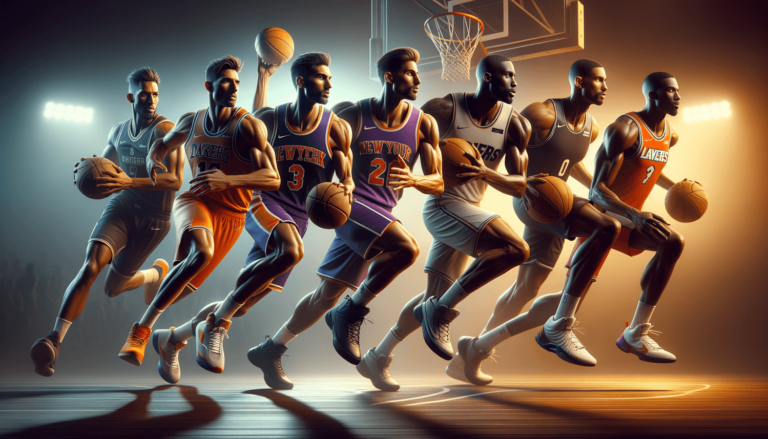
Development of Basketball Player Archetypes
Written by: Basketball Universe
Last updated:

Step right onto the court as we delve into the ever-evolving world of basketball player archetypes! In this fun and informative blog post, we’ll explore the fascinating journey of how these distinctive player types have emerged, transformed and diversified over the years. From dominant big men to crafty playmakers, the rich tapestry of player personas has become one of the most intriguing aspects of the game, offering a world of strategy and excitement for coaches, players and fans alike. So lace up your sneakers and get ready to enjoy an all-access pass into the development of basketball player archetypes!
Development of Basketball Player Archetypes
The development of basketball player archetypes traces back to the early days of the sport when players assumed specialized roles. As basketball evolved, the roles diversified, and key positions formed, including centers, forwards, and guards. These positions led to distinct playing styles, such as the shot-blocking big man or the playmaking point guard. Over time, player athleticism, skill sets, and coaching strategies further shaped the archetypes, transcending traditional position boundaries and giving rise to versatile hybrids like the point forward, stretch four, and 3-and-D specialist. Today, basketball player archetypes are dynamic and continue to evolve, reflecting the sport’s complex strategic landscape and adaptability to changing trends.
A Stroll Down Basketball History Lane
Before we dive into the evolution of basketball player archetypes, let’s take a brief stroll down basketball history lane. Basketball was invented in 1891 by Dr. James Naismith, a Canadian physical education instructor, as an indoor sport to keep athletes active during the winter months. From its humble beginnings in a YMCA gymnasium to the hardwood courts of the NBA, the game has come a long way, and so have the players. As the sport grew in popularity, various playing styles emerged, giving rise to basketball player archetypes we see today.
The Genesis of Traditional Positions
The early development of basketball player archetypes can be largely attributed to the formation of key positions that formed the core structure of a basketball team. Let’s explore these positions and their initial position-specific roles.
Centers
Centers have been a bedrock of basketball since the beginning. Typically, the tallest players on the team, centers assumed the responsibility of controlling the paint on both offense and defense. Anchoring the team with their imposing size and strength, centers focused on collecting rebounds, blocking shots, setting powerful screens, and scoring close to the basket. Early center archetypes mainly revolved around players like George Mikan, Bill Russell, and Wilt Chamberlain – giants who dominated the game with their size and skill.
Forwards
The forward position comprises two distinct roles – the small forward and the power forward. Initially, power forwards were similar to centers in their duties, albeit slightly smaller and more mobile. They complemented centers in the low post, aiding in rebounding and interior scoring. Small forwards, on the other hand, were required to possess the versatility and athleticism to contribute in various aspects of the game, such as scoring, rebounding, and defense. Early forwards such as Elgin Baylor, Dave DeBusschere, and John Havlicek showcased the prototype forward archetype of the bygone era.
Guards
Guards are typically the smallest players on the court, and their archetypal roles centered around playmaking, ball-handling, and perimeter defense. Traditionally divided into point guards and shooting guards, their primary responsibility was to orchestrate the team’s offense. While point guards were responsible for setting the pace of the game and functioning as court generals, shooting guards were relied upon as primary scorers and perimeter defenders. Notable guards from basketball’s early years include Bob Cousy, Jerry West, and Oscar Robertson, who exemplified the classic guard archetype.
The Emergence of New Player Archetypes
As basketball and its athletes evolved, so did player archetypes. In this section, we’ll discuss how different eras of basketball conceived unique and game-changing archetypes that defied traditional position conventions and challenged previous norms.
The Arrival of the Skyhook and the Versatile Center
Throughout the 1970s and 80s, the center position experienced a transformation. Kareem Abdul-Jabbar, one of the most prolific scorers in NBA history, brought the skyhook – an unstoppable sweeping hook shot – to the forefront of the league. The center archetype began to evolve as centers began to borrow elements from other positions; they developed footwork, finesse, and agility. Players such as Hakeem Olajuwon and David Robinson, equipped with guard-like skills while maintaining traditional center roles, marked the arrival of versatile centers.
Small Ball and the Stretch Four
Thanks to fast-paced offenses and a heightened focus on spacing, the small-ball era of basketball emerged. Enter the stretch four – an evolution of the power forward position, which combined the size and strength of a traditional power forward with the shooting prowess of a guard. Player archetypes like Dirk Nowitzki and Rasheed Wallace broke barriers with their ability to score from the three-point line while still holding their own inside the paint. The stretch four has had a massive impact on the evolution of basketball strategy, proving invaluable to teams seeking to exploit mismatches and create space on the court for offensive versatility.
The Point Forward Phenomenon
Imagine a player with the commanding presence and physique of a forward but equipped with the ball-handling, playmaking, and court vision of a point guard. Enter the point forward – an archetype epitomized by legends like Magic Johnson, Larry Bird, and Scottie Pippen. This unique fusion of size and skill allowed teams to experiment with unconventional lineups, disrupting opposing defenses with their unprecedented versatility. Today, the point forward is a sought-after commodity in the league, and new-age point forwards such as LeBron James and Ben Simmons carry forward the legacy of this fascinating archetype.
The Rise of the 3-and-D Specialist
In a basketball landscape increasingly focused on efficiency and spacing, the importance of the three-pointer skyrocketed. A new breed of players, capable of contributing heavily on both ends of the court, known as the 3-and-D specialist, soon emerged. These players can not only knock down three-pointers at an impressive clip but also possess the ability to hound opposing scorers on defense. Players like Bruce Bowen, Shane Battier, and Robert Horry carved out noteworthy careers as early 3-and-D archetypes, while contemporary pros like Klay Thompson, Danny Green, and Robert Covington continue to redefine the value of this skill set.
Contemporary Basketball: Positions and Archetypes Blur the Lines
The modern era of basketball showcases exceptional player development and a willingness to experiment with unorthodox lineups, resulting in new hybrid archetypes and positionless basketball concepts. Draymond Green, for example, excels as a small-ball center despite his 6’6″ stature, thanks to his exceptional combination of defensive intelligence, playmaking, and all-around versatility. Meanwhile, the ‘unicorns’ – players like Giannis Antetokounmpo, Kevin Durant, and Kristaps Porzingis – defy the constraints of traditional basketball positions with their unique combination of size, skill, and agility. Likewise, the surge in popularity of small-ball lineups has given rise to new player archetypes like the ‘positionless’ wing and the guard-playing center.
The Future of Basketball Player Archetypes
As the game of basketball continues to evolve, so too will its player archetypes. The growth of skill development, sports science, and innovative coaching approaches will likely foster even more unique and adaptive player profiles, reshaping the game’s strategic landscape in exciting ways. Looking ahead, the future of basketball player archetypes is full of promise, and we can’t wait to see what the next wave of basketball talent has in store.
Unlocking Potential: Player Development Shaping Archetypes
Player development plays a critical role in shaping and diversifying basketball player archetypes. As players hone their skills, embrace work ethic, and strive to improve, they pave the way for new archetypes to emerge. Let’s take a look at some of the essential factors responsible for the development of unique and game-changing archetypes.
Technological Advancements and Sports Science
Today’s basketball players benefit immensely from technological advancements and sports science that enhance their physical attributes and overall performance. The implementation of state-of-the-art training equipment, performance analytics, and innovative recovery methods contribute significantly to the development of new archetypes. Technology provides players with insight into their strengths and weaknesses, allowing them to refine their skills and exploit their physical advantages to the fullest.
Coaching Philosophy and Strategic Evolution
Coach-player relationships and strategic decisions have a considerable impact on molding player archetypes. Basketball coaching has evolved over the years, with each generation embracing new ideas and tactics. As coaches experiment with unconventional lineups, unorthodox systems, and innovative tactics, they create opportunities for diverse player types to find their niche in the game. Coaches willing to adapt their strategies to suit the skillsets of their players have been instrumental in the evolution of many groundbreaking player archetypes.
The Global Influence on Basketball Archetypes
Basketball is a global sport, and international players have had a profound impact on the game’s landscape. From Europe’s motion-based offenses to South America’s aggressive style of play, international players bring unique perspectives and skills that influence and diversify the range of player archetypes. Examples include Dirk Nowitzki popularizing the stretch four, Arvydas Sabonis showcasing versatility at the center position, and Tony Parker mastering the craft of the scoring point guard. The influx of global talent enriches the game of basketball, expanding the possibilities for player archetypes to emerge and thrive.
Player Adaptability and Versatility
Adaptability and versatility among basketball players have accelerated the emergence of new archetypes by allowing them to take on multiple roles on the court. The modern era of basketball values multifaceted players who can excel in various aspects of the game. As a result, players are encouraged to develop a diverse skill set, facilitating the rise of new and increasingly versatile archetypes that reshape the strategic landscape of the sport. Players capable of fulfilling multiple roles on the court not only become valuable assets to their teams but also set the stage for the next generation of transformative player archetypes.
FAQ: Diving Deeper Into Basketball Player Archetypes
Get ready to learn even more about basketball player archetypes! We’ve compiled a list of frequently asked questions to help you gain more insight into the fascinating world of player profile development. From position fundamentals to the impact of specific archetypes, these answers aim to satisfy your curiosity and enhance your understanding of the game.
1. Why are there traditional positions in basketball?
Traditional positions exist in basketball to establish a basic framework for roles and responsibilities on the court. They provide structure and balance, ensuring teams have a defined center, forwards, and guards to cover different aspects of the game.
2. What are the main basketball positions and their duties?
The main basketball positions are center, forward, and guard, further categorized into sub-positions. Centers focus on controlling the paint, forwards contribute in various aspects of the game, and guards primarily function as orchestrators of the team’s offense.
3. How have basketball positions evolved over the years?
Over time, basketball positions have evolved as players adopted new skillsets, coaching strategies diversified, and the game experienced different eras. This evolution has led to hybrid and positionless archetypes, which defy traditional position boundaries and demonstrate unprecedented versatility.
4. What is “positionless basketball”?
Positionless basketball refers to a playing style where players swap roles or handle multiple responsibilities on the court. Instead of being bound by traditional position conventions, players leverage their versatile skillsets to create new opportunities and challenge opposing defenses.
5. How have international players influenced the evolution of basketball archetypes?
International players have brought diverse perspectives, unique skills, and distinctive playing styles that have contributed to the development of new basketball archetypes. These players have popularized different roles, expanded the range of player types, and enriched basketball’s strategic landscape.
6. How do coaching philosophy and strategy impact player archetypes?
Coaching philosophies and strategies play a crucial role in shaping player archetypes. As coaches embrace new ideas, experiment with unconventional lineups, and adapt their tactics to suit their players’ skillsets, they create opportunities for diverse player types to emerge and thrive.
7. What is the role of sports science and technology in the development of new player archetypes?
Sports science and technology play a significant role in enhancing player performance and facilitating the growth of new archetypes. The implementation of cutting-edge training equipment, performance analytics, and recovery methods allows players to refine their skills, exploit their physical advantages, and push the bounds of basketball player archetypes.
8. How do players benefit from being versatile and adaptable?
Players who are versatile and adaptable can excel in various aspects of the game, allowing them to fulfill multiple roles on the court. This not only makes them valuable assets to their teams but also sets the stage for the emergence of new and transformative player archetypes.
9. Can a player change their archetype during their career?
Yes, players can change their archetype during their career by developing new skills, adapting to different roles, or evolving their playing style. This flexibility allows them to expand their skillsets and stay relevant in a constantly evolving basketball landscape.
10. What factors contribute to the emergence of new basketball player archetypes?
Several factors contribute to the emergence of new basketball player archetypes, including player development, coaching philosophy, global influence on basketball, technological advancements, adaptability, and strategic evolution. These factors combine to shape and diversify basketball player profiles over time.
Featured Posts
- No pillar pages found.





